
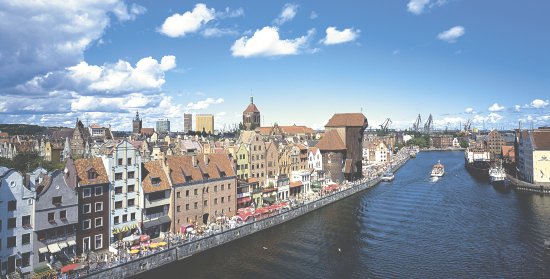
Poland, Republic of Poland - landlocked
country in the north of Central and Eastern Europe. Area - 321.7
thousand square meters. km.
The northern part of the country is a low shore of the Baltic Sea with
dunes and sandbars. Baltic Sea juts into the land of Gdańsk Bay closed
to the sea Hel oblique, Vistula Lagoon from Vistula oblique and shallow
Szczecin Lagoon. Northern and central part of the country has an
extensive Polish Lowland. To the south of it are the Silesian Lowland,
the Cracow-Częstochowa Upland, the Malopolska Upland with Sven-tokshiskimi
mountains up to 612 m and Lublin Upland up to 390 m. Between the last
two is Sandomierz Basin. Extreme south of the country is mountain ranges
in the west - the Sudetenland the highest point - Mount Snowball, 1602
m, in the east - the Western Carpathian Mountains highest point - Mount
Rysy, 2499 m.
Climate in Poland
The climate is
temperate, with the transition from the sea (in the north and west) to
continental (in the east and south-east). The average January
temperature in the lowland areas of -1 ... -5 ° C in the mountains -8 °
C, in July +19 ° C and +10 ° C, respectively. Precipitation falls in the
lowlands of 500-600 mm per year, in the Pomeranian and Masurian Lakes -
700-900 mm, in the southern mountain areas - up to 1200 mm.
Traditions of Poland
You can get acquainted
with the country, looking at her from the window of a tourist bus or a
hotel, satisfied with the information contained in the guide. But the
emotional relationship to the places visited can only occur under the
influence of direct contact with the people living there, as it is
familiar with their customs, culture and traditions not only leaves a
trace in our memory, but also the soul.
Poles are considered people who love holidays, observant, longstanding
customs. Old rituals, especially those that date back to pagan times,
have long lost their magical character, becoming a relic of the past and
a colorful part of the game.
In this Catholic country, many customs are closely related to religion.
Easter and Christmas is a holiday, like New Year's, and the most
interesting event of Easter - Celebration of Holy Week at Calvary. Then
arrange the whole theatrical performance: entry of Christ into Jerusalem
on Palm Sunday, the crucifixion of the Holy Friday and, of course, the
resurrection of Jesus. Numerous spectators sometimes so involved that
even the attempt to free Jesus from the "Roman soldiers". And about
Bernardine monastery of the 17th century built 42 chapels, representing
the procession.
With the Easter holidays were associated with various local traditions.
In Krakow was very popular (and still is) the so called "Emaus" -
festivities that are held in memory of the way the apostles in the town
of Emaus. Street vendors laid out on the shelves of cheap shiny
ornaments, whistles, toys and sweets.
Krakow's apprentice, and the young men who came to the city to "Emaus"
from the surrounding villages, flirted with girls, slapping their willow
branches, and demonstrated their prowess in cane valiant battles. The
crowds who gathered at the Church and watched the procession of
religious brotherhoods, walking on the sidewalks with tambourines, with
the banner of brotherhood and holy images. Today, on the shelves, in
addition to traditional toys and handicrafts there, unfortunately,
printed plastic trinkets, but all the same, "Emaus" still brings great
joy and kids and adults.
Experts believe that the views of all the Easter Europe is perhaps the
oldest and interesting. November 1 everywhere celebrate All Saints Day,
November 2 and commemorate the dead. According to popular belief, the
day of commemoration of the souls of dead leaves graves, attend a
memorial service in the church and returned to the home of soy.
Souls to be easier to get into the house, relatives often open the doors
and windows, leaving food and drink, trying not to displease these
guests and enlist their help. Memorial Day - "zadushki" - very solemnly
celebrate today. Relatives gather together to visit the graves of their
loved ones, light candles.
Very popular mass pilgrimages to places of worship. Among the holy
places for Catholics, above all, we should mention the Czestochowa
monastery at Jasna Gora, the Jews in such a place is the grave of the
tzaddik in Leżajsk, and for the Orthodox - Grabarka.
Holiday, in Polish tradition occupies a very important place, is
Christmas. The special atmosphere in Rozhestva Eve - Christmas Eve (in
Poland it is called Vigilius). On this day most associated rituals,
customs and beliefs. Christmas Eve - the Polish family holiday.
Important role in creating a festive atmosphere is design a house or
apartment. The main decoration is elegant tree, which are in the
Christmas holiday. But this is one of the newest holiday traditions. The
first Christmas tree appeared in Poland in the XIX century. Mainly in
German houses and homes for residents of evangelical religion - natives
of Germany. Gradually the custom of dressing the Christmas tree spread
across Poland. Earlier, the Polish home on holidays only decorated with
branches of conifers.
Attractions in Poland
Malbork
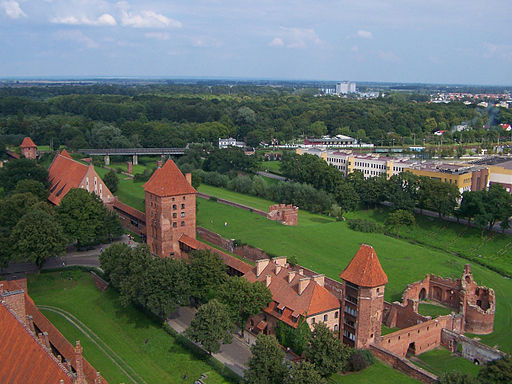
Malbork is best known for
its castle - the largest Gothic castle, not only in Poland but also in
Europe. In addition, the strength of Malbork is the largest brick
building, which man has ever built. The fortress was built over 200
years old, dating from the 13th century.
Malbork was an example of military architecture of the Middle Ages. A
built these building Jerusalem German House Hospital Order of the
Blessed Virgin Mary, the short title of which the Teutonic Order.
Knights named the town in honor of his patron Mary Marienburg. Later
this name was transformed in Malbork.
The Teutonic Order was founded in the East during the Crusades. After
the failure that haunted knights in battles with the Muslims, Duke
Conrad of Masovia invited the Teutonic Order in the Baltic tribes to
fight the Prussians, who ravaged the land of the Polish principalities.
In 1226, Conrad has agreed with the establishment of the Order of the
Knights of the settlements on the border to defend the Duchy of Mazovia.
Wieliczka Salt Mine
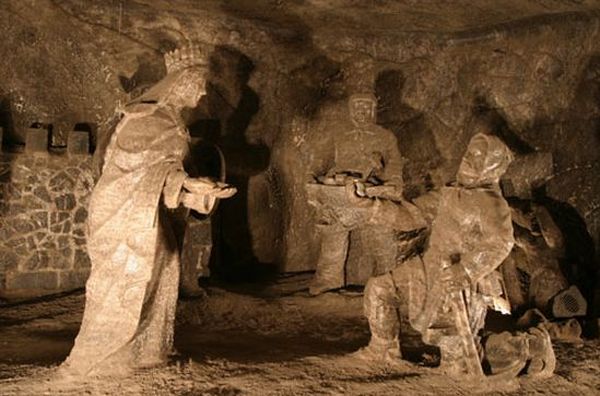
Wieliczka, you can say a
suburb of Krakow, so when we got almost to the city, he immediately hit
the usual city traffic jams. In this regard, we did not even have time
for accommodation and we had to immediately go with things to Mine.
Managed to 2 minutes before closing! Still, we managed to get in, and
then the tour has already begun to flow in slow rhythm.
I'll tell you a little history first. The salt mines were opened almost
in the 15th century. Since their discovery is bonded one beautiful
legend. One Hungarian royal family decided to give his daughter in
marriage to the Polish king. This girl's name was King. And when King
went to her future husband to Poland, she threw her wedding ring in a
well near the house. When she got to the Wieliczka (then this place is,
of course, not so called), in one of the places ordered to dig a well
(like, she had a dream with omen). When the well was dug, then it got to
the bottom of a crystal object that was walled her wedding ring! Ie her
ring on groundwater proputeshestvovalo her, and returned to it in
Poland. That's how the salt mines were opened, as ring it was in a great
piece of crystalline salt. Now King is considered sacred, and her
sculptures often caught in the underground mines of Wieliczka. And the
great hall, which houses the chapel under the ground, is named in honor
of St. Kinga.
Well, now in order. First we went down for a long time on a small,
narrow staircase. I counted - 53 span. All the walls and ceiling of the
tunnel made of wooden beams, on which there is no living space - the
entire surface of the wood is painted. Wishes, names, dates, and other
writings, usually leave fans "graffiti" in all languages. Then, when we
went down to a sufficient depth (something about 60 meters) we were led
through the halls, each of which has its own attractions. And so
gradually, moving from room to room, we went down lower and lower until
it reached the level of 135 meters. Length - 3 km. This so-called
tourist trail. Then there is the route for extremists. It is 8 km long
and goes down to 162 meters. The underground halls there's even a
sanatorium for people with asthma, as considered that the air shafts is
very useful.
At first it was scary, did you go down into the earth, who knows what,
suddenly fill up, or air will be enough, and in general - who knows what
... But it was not scary. All the walls and ceilings in the halls and
passages between them, securely fastened everywhere installed
ventilation, maintained a constant flow of air and the temperature was
15 degrees. The main thing to keep and not to turn away ...
Each hall tour guide will tell you what this place is remarkable in what
century developed a "cave", allow to lick the walls, floor or ceiling
(to whom he wants.) Early on in the tour guide joked that the mines can
not do this and that, but there are some things that you can do. Namely,
each tourist can lick salt from the walls of a total weight of 2 kg of
course a joke, but in my opinion, every time though, and kissed
somewhere. Interesting fact to know, and whether or not the wall - a
lump of salt? With full responsibility - all the walls are really made
of salt
Miners - people are very superstitious and religious, as they always
have to risk your life, so it is from the 15th century underground
Storey small chapel, where miners could pray without leaving the mines.
They had to be under the ground for hours, the way up was very
difficult, so it is much easier to build a chapel right in the mine.
Initially, the chapel made of wood, but after mnogochsilennyh fires and
many victims, used to build the tree was banned. But miners our way out
- they began to make pictures of saints from what was on hand in
abundance - from rock salt. Since then, and it has begun to develop arts
carved rock salt. Now in each room are located throughout various
sculptures, statuettes, murals, etc., etc., etc., made by the miners
themselves. Even the chandeliers in mnogiz halls made of salt. However,
not stone, and from the crystal, the same as what we see at home with a
salt shaker.
Many rooms are entire compositions of mannequins depicting scenes from
the everyday work of miners. Demonstrate how they worked and what
inhumane working conditions were these people. On his back he had to
carry the bags of rock salt, huge jars of salt water (which was also
used for the production of salt), with just two pairs of arms and
conventional flywheel, they had to pull out the huge vats of water to
the surface. Also, along with people, worked in the mines and horses
that were conducted underground all his life. The most amazing thing is
that it turns out, the last horse who worked underground, was the
removal from the mine a few years ago!
Cities in Poland
Warsaw
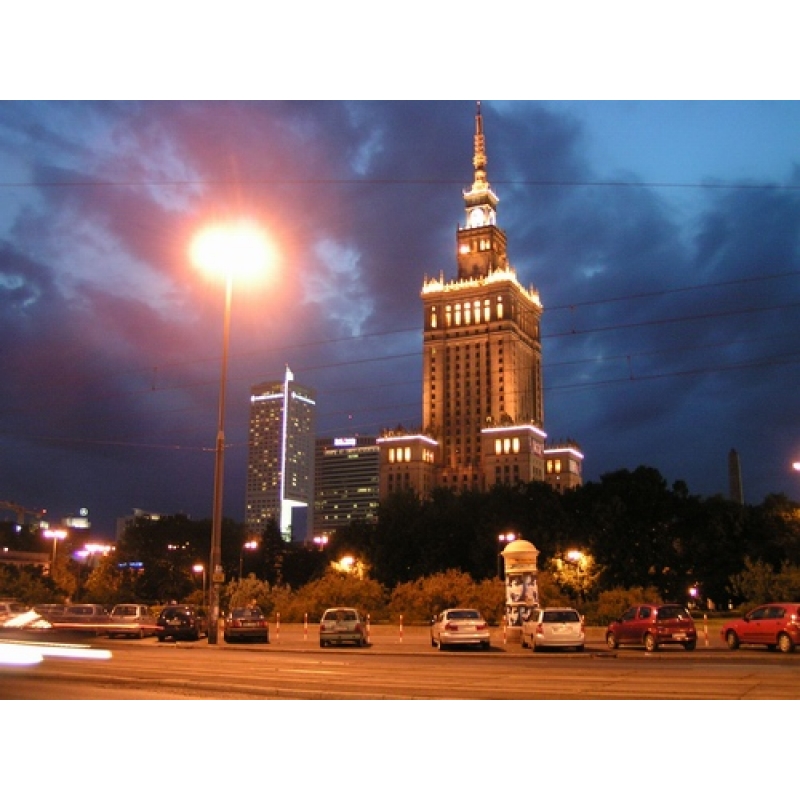 Founding
year of Warsaw unknown, but in the annals of the XIII century can be
found on the City of Post Mazovian princes. In 1596 King Sigismund III
Vasa moved the capital from Krakow to Warsaw, and this year is the
capital city of Warsaw. Turbulent history of Warsaw's very interesting.
, During the last war had been destroyed three times. Out of every four
of five houses lay in ruins - but Warsaw has risen again became the
capital of the country. And now you can find pre-war places of the city.
Founding
year of Warsaw unknown, but in the annals of the XIII century can be
found on the City of Post Mazovian princes. In 1596 King Sigismund III
Vasa moved the capital from Krakow to Warsaw, and this year is the
capital city of Warsaw. Turbulent history of Warsaw's very interesting.
, During the last war had been destroyed three times. Out of every four
of five houses lay in ruins - but Warsaw has risen again became the
capital of the country. And now you can find pre-war places of the city.
Located in the center of the country Warsaw, although it was founded
relatively late (compared to other Polish cities), at the beginning of
the XIV century, since 1611 she has managed several times to visit the
country's capital. As has long been the cultural and industrial center
of Warsaw, called the Paris of the North, was one of the most beautiful
and sophisticated cities in Central Europe for as long as it was
virtually wiped out during World War II. In fact, Warsaw - the post-war
product and in appearance and spirit. While many of its historic
monuments have been restored, much of the city has done so in a modern
style. A new species of Warsaw impressive, despite the fact that there
are many neighborhoods with Stalinist buildings and simple does not
stand out buildings.
The city is divided Vistula in two. In the western sector of the left
bank of the river is the city center and the "old town" north of the
center. Almost all the attractions and most of the tourist sector are
found on this side of the river. On the right bank in the suburb of
Prague no major attractions and very few tourists.
The old city was rebuilt from scratch since there remained only a pile
of rubble after the Second World War. Restoration of commemorative
structures, which were built between 1949 and 1963, was designed to
restore the previous form of XVII-XVIII centuries. Each architectural
piece, found in the ruins, has been used in the recovery process.
Zakopane
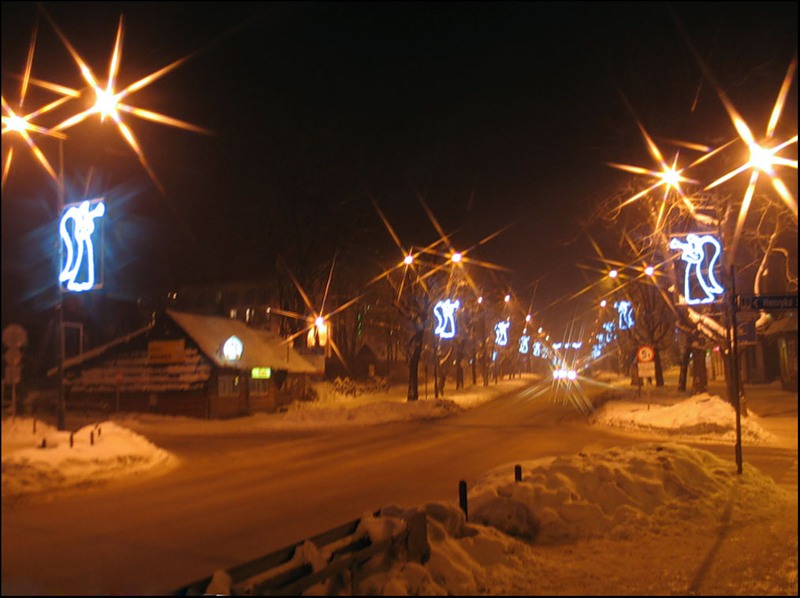 Zakopane
is - resort city in southern Poland, situated at the northern foot of
the Tatra Mountains at an altitude of 850 m above sea level. Located 100
km from the city on the border with Slovakia in the intermountain basin
Podhale. Population - 27.4 million people (2006) - is mainly engaged in
servicing tourists.
Zakopane
is - resort city in southern Poland, situated at the northern foot of
the Tatra Mountains at an altitude of 850 m above sea level. Located 100
km from the city on the border with Slovakia in the intermountain basin
Podhale. Population - 27.4 million people (2006) - is mainly engaged in
servicing tourists.
As a mountain, health and beauty resort of Zakopane develops in the
second half of the 19th century. The local mountain air contributes to
the treatment of tuberculosis, respiratory diseases, anemia and
accelerates the flow of recovery.
Weather station Zakopane is known since 1870, and in 1899 to the resort
was put on the railroad. Zakopane received city rights in 1933, and
since then the city is the tourist center of the Polish Tatras.
Zakopane is considered one of the best Polish ski resorts, as well as
the largest center of mountaineering and tourism, it is called the
winter capital of Poland. Each year, the city is visited by about 2
million tourists, including many foreigners. The resort large sports
history: in 1910, it hosted an international competition skiers, three
times in Zakopane held world championships in classic forms of skiing (FIS),
three times - Winter Universiade. Each year in January, on the slope of
Krokve competitions of the World Cup in skiing.
In the neighborhood there are small villages, from which cable cars
deliver tourists to the mountains. From Poronin - village, located in
the north-east of Zakopane - beautiful views of the Tatra Mountains. In
the village and in the immediate vicinity, there are 12 lifts. Village-Białka
Tatrzańska lies 20 kilometers from Zakopane over the river Bialka, one
of the most beautiful and cleanest rivers in the Tatras. The village is
famous for its ski slopes, most of which are equipped with modern ski
lifts, held lighting, and the slopes are covered if necessary with
artificial snow. In Bukowina Tatrzańska (15 km from Zakopane) are a
large number of ski slopes, ice rinks, there is a ski jump. Summer is
also well developed tourist center. From the village of Murzasichle,
lies just 6 km from Zakopane, boasts stunning views of the Polish and
Slovak Tatras from here that most of the tourist mountain routes. There
are six lifts.
In Zakopane six major ski areas at altitudes of 860-2000 m, which has
different levels of difficulty. A total of 60 lifts in Zakopane, the
total length of slopes greater than 65 km. Lift station connected by bus
lines and buses.
The largest ski area Mt Kasprowy Wierch located in the Tatra National
Park. To get to the top of the mountain can be commuter cable car or by
chairlifts and drag lifts. This slope is a rather complex, like the
northern slope of Mount Nosal, located in the southeast of the city.
Easier slopes and located on Gubałówka, Glade, and Szymoszkowa Butorova-top.
Beginners, tourists with children and lovers of quiet family skiing
should pay attention to a lot of ski lifts are installed on private
slopes directly in Zakopane - the uplands Antałówka, Kozinets, under
Nosal Budzovskom on horseback, in Kościelisko, and many other places in
the resort.
Opole
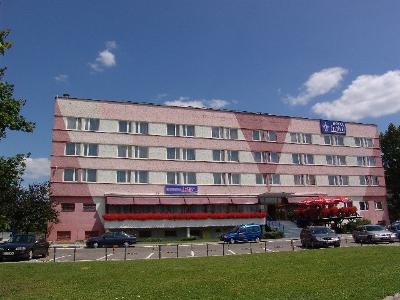 Opole
- Poland charming town situated on the River Oder in the 85th km
in the south-east of Wroclaw. Opole also known Oppeln in German.
The population of the city of Opole is approximately 129 553
people.
Opole
- Poland charming town situated on the River Oder in the 85th km
in the south-east of Wroclaw. Opole also known Oppeln in German.
The population of the city of Opole is approximately 129 553
people.Opole - Opole Voivodeship is the capital of Lower Silesia. Opole was occupied by the Germans years ago. According to legend, the first inhabitants of Opole lived on the island, known as Wyspa Pasieka, which is located in the center of the Oder River. In the Middle Ages - the capital of an independent principality. From this period, preserved the most valuable architectural monuments.
Opole already in VIII century Slavic settlement was important in the years 1201-1532 - the capital of Piast principalities, which in 1327 came under the power of the Czech Republic, and in 1532 - under the rule of Gasburgov. In 1740, the city took over the Prussians. Since that time, reinforced Germanization.
Opole is not only the capital of Polish songs, but also a city of cultural values, science, tourism and business. This is a small town, but charming, and its numerous canals and gardens give it a special charm. Residents are proud of Opole as the historical past of the city.
Interesting sights on the island Apiary is Piast Tower 13th century - the balance of the former castle, the Gothic Cathedral of St. Cross, the church and convent of the Franciscan Order from Piast Chapel - Piast mausoleum. City Hall is modeled after a Florentine PalazzoVecchio and baroque stone houses surrounding the market square in the old town. Amphitheater in Opole festival organized Polish songs. The area is a museum of the Opole Berkovitsa village. In Ethnographic Museum-Reserve moved house from the Opole region. The building of the former Jesuit college a museum Opole Silesia.
The name of the city - Opole - comes from the historical Polish word "Opole," which means the basic organizational unit of the tribe of the Slavs. According to another version it is assumed that the name of the town comes from the word "field." According to a legend - once the leader of a tribe became lost while hunting in the dense forest, and when, after a few days he finally ran into a settlement of the people, he cried: "Oh! Field ». And later ordered the construction of the city at this point.
Proud of his dating back to the IX century history Opole is among the most ancient cities of Poland. The first mention of the most important city opolyan (one of the Slavic tribes), located on the Oder River, located in the historical written sources of the second half of the IX century, "The Geography of Bavaria."
Opole base as the city was the signature, in 1217 Casimir I - grandson Boleslaw Krivoustogo - instrument in force act terrain. This document has been installed capital Opole Opole-Rachibozhskogo principality. By order of the Casimir I in 1283 on the island of apiary, which is the Oder River, the castle was built Piast - princely ancestral castle.
Opole location at the crossroads of major trade routes brought the city a sale.
After the death of the last ruler of the Piast dynasty Opole was annexed to Brandenburg, and later - to Prussia. Prussian rule contributed to the massive influx of settlers into the city from Germany, which accelerated the already rapidly evolving process of Germanization.
In 1751, the population of Opole was 1186 people. After the establishment of this center in 1816, the Regency town began to develop. Construction of the first railway line linking the cities Brzeg Opole and Wroclaw, was finished in 1843. Commissioned in 1859 cement plant gave rise to the development of the cement industry, which was a significant factor in its overall development.
After the partition of Silesia, Opole in 1922, together with the large area Upper Silesia were annexed to Germany. A March 24, 1945 the city was handed over to the Polish authorities, at the time there lived 200 permanent residents. During World War II, more than 900 buildings, most of the industry, as well as all the bridges in the city were destroyed, but the restoration of the city began immediately after the war. Opole became the capital of the province in 1950, and since then has been actively developing as a cultural, scientific and industrial center, the center of tourism and business.
Auschwitz
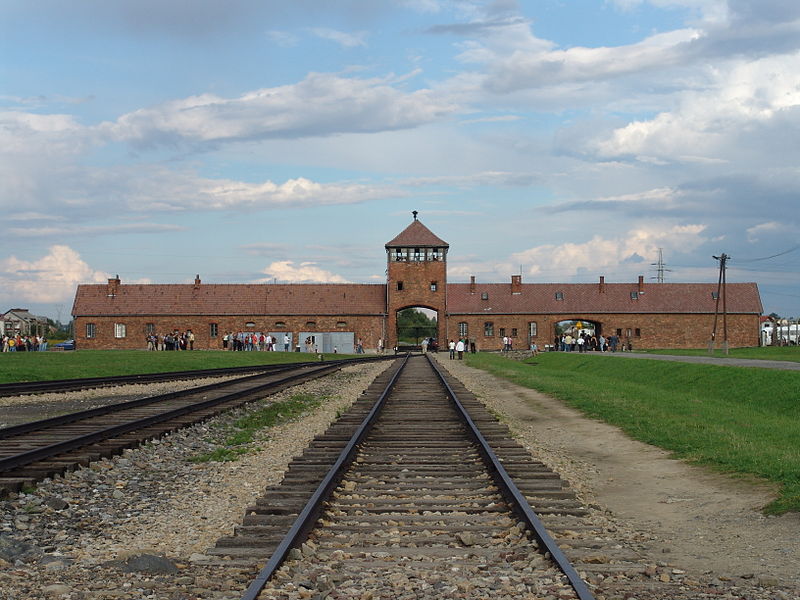 The origins
of the camp can be dated to early 1940, when the SS sent a commission to
the Polish town of Oswiecim (German: Auschwitz) to determine whether a
set of barracks that had been constructed outside the town during WW1,
and that between the wars had been used by the Polish military, could be
used as a concentration camp. Although the initial report was negative,
a later inspection determined that the change of use would be possible
after some construction works. Another commission, headed by SS-Hauptsturmführer
Rudolf Höß, visited Auschwitz on 18-19 April 1940. Höß' report seems to
have carried the most weight, for on 27 April 1940 Reichsführer-SS
Heinrich Himmler ordered the establishment of a concentration camp in
Auschwitz and on 4 May appointed Rudolf Höß as its commandant.
The origins
of the camp can be dated to early 1940, when the SS sent a commission to
the Polish town of Oswiecim (German: Auschwitz) to determine whether a
set of barracks that had been constructed outside the town during WW1,
and that between the wars had been used by the Polish military, could be
used as a concentration camp. Although the initial report was negative,
a later inspection determined that the change of use would be possible
after some construction works. Another commission, headed by SS-Hauptsturmführer
Rudolf Höß, visited Auschwitz on 18-19 April 1940. Höß' report seems to
have carried the most weight, for on 27 April 1940 Reichsführer-SS
Heinrich Himmler ordered the establishment of a concentration camp in
Auschwitz and on 4 May appointed Rudolf Höß as its commandant.